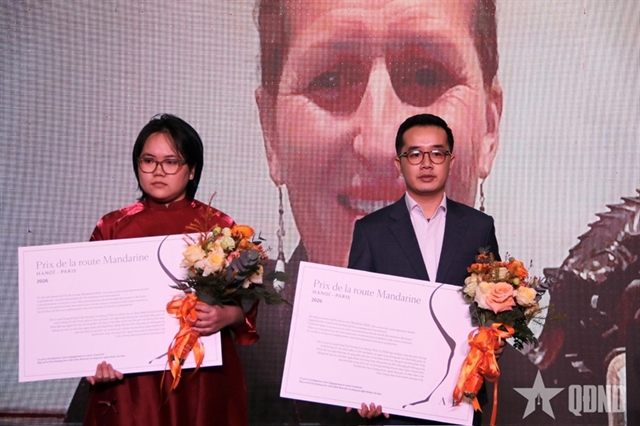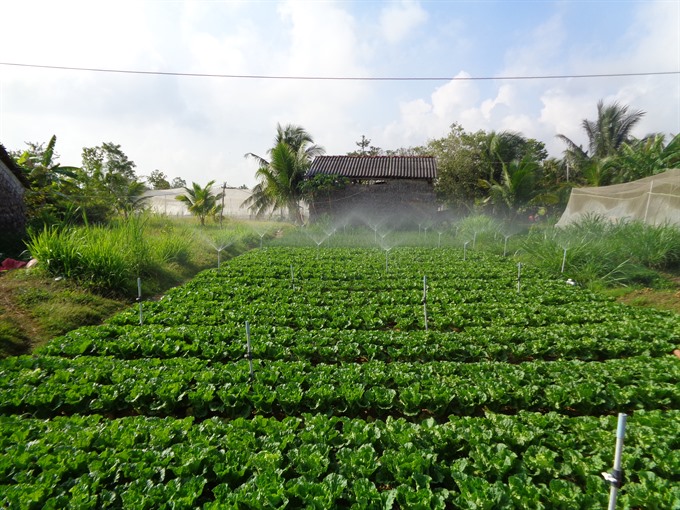 Society
Society

On his 2,000sq m vegetable farm in Trà Vinh Province, Thạch Bảy was working to the tune of a revolutionary song playing on his old mobile phone.
 |
| Sơn Thái Bình checks the quality of his first peanut crop, grown with support from the AMD Trà Vinh project. |
by Hoàng Nguyên
TRÀ VINH – On his 2,000sq m vegetable farm in Trà Vinh Province, Thạch Bảy was working to the tune of a revolutionary song playing on his old mobile phone.
He was watering baby lettuce that had been planted a week ago on his farm in sleepy An Quảng Hữu commune Trà Cú District.
“I love music. I usually listen to music while I’m working,” the 60-year-old said as he took out his phone from his front pocket.
He and his wife, who grow lettuce, choy sum and Vietnamese spinach on their farm, once earned around VNĐ150,000 (US$7) per day from selling vegetables.
Now, however, during the peak harvest season, he makes double that amount (VNĐ300,000) per day, thanks to a new automatic sprinkler system, which has saved irrigation water and reduced the number of working hours.
“My work now can be done more quickly and easily. Before the sprinkler was installed, sometimes I couldn’t water vegetables fast enough, so they lost their freshness and died,” Bảy said.
Bảy’s family belongs to a “clean vegetable” growers group established with financial and technical assistance from the project “Adaptation to Climate Change in the Mekong Delta” funded by the International Fund for Agricultural Development (IFAD).
Implemented in Bến Tre and Trà Vinh provinces, the project aims to develop sustainable livelihoods for the rural poor and enhance communities’ capacities to adapt to climate change.
Trà Vinh is one of the provinces in the country most affected by saline intrusion and drought. During the dry season, districts like Trà Cú, Cầu Ngang, Tiểu Cần, Châu Thành and Duyên Hải often face a shortage of water for irrigation.
Before the project, no one in the commune had ever thought of installing an automatic sprinkler, according to vegetable grower Kim Thị Dẻ, 50, a neighbour of Bảy.
“Even if they had thought about it, they wouldn’t have had the money to invest,” she said.
The total investment needed for 1,000sqm of land is VNĐ20 million, including VNĐ4 million for the sprinkler irrigation system. The project funds nearly half of the total cost, with the rest must from farmers. Ten per cent of the counterfund from farmers must be invested in cash, or around VNĐ2-2.5 million per 1,000sqm of land.
Such large investments can be a burden for members of poor and near-poor households.
An Quảng Hữu commune is one of the areas with a high number of poor and ethnic-minority households. One-third of the commune’s 3,016 households are classified as poor, and more than 50 per cent of the poor are ethnic Khmer.
To join the vegetable farmers’ group, poor and near-poor farmers like Bảy and Dẻ have access to loans from the Climate-Change Adaptation (CCA) co-sponsoring fund administered under the AMD project.
The loan can be paid back in monthly installments of VNĐ600,000 over an eight-month to one-year period.
According to the project’s half-term report, the fund has lent money to 2,580 households in 30 communes in the province since the start of the AMD project in 2014.
More than 90 per cent of the borrowers are members of farmers’ groups. Starting with only five participants, the vegetable farmers’ group now has 32 members. Of these, more than 50 per cent are Khmer, and more than 50 per cent are from poor households.
Peanut growers
Besides vegetable farmers, peanut growers in Long Sơn Commune in Trà Vinh’s Cầu Ngang District have received similar support from the AMD project.
In the past, Sơn Thái Bình, 46, who has been growing peanuts for about three years, grew the nut in a paddy field a few kilometres away from home since there was enough water there for irrigation.
After installing the sprinkler system, however, he was able to grow nuts on a 2,000sq.m garden in front of his house.
“I only need to water the garden every two days. So I only take care of the garden for half a month, and the other half I do other jobs,” he said.
Bình is a member of the Thắng Lợi peanut farmers’ group which includes 18 households who are trained in seed and land treatment and the correct use of fertiliser and pesticides, said Thạch Sao, the group’s team leader.
“Before the sprinkler system, we just watered the plant and would wait to see if it would grow, without using any special kind of technique. We just did it based on experience,” Sao said.
At that time, the highest yield per 1,000 sq.m of peanuts was about 600-700 kilogrammes, but now it can reach 800-900 kilogrammes.
Still, he worries about prices as peanut growers can only sell to traders who have control over setting the price.
The price of peanuts in the last two years has inched down. The average price during harvest season (in March and April) this year has been VNĐ11,000-12,000 per kilogramme, while a few years ago it was VNĐ14,000-16,000.
Last year, a peanut grower made a profit of about VNĐ2-3 million per 1,000 sq.m, according to Sao.
Challenges
Huỳnh Nghĩa Thọ, director of the Trà Vinh AMD project, said that increasing market participation for poor farmers remains an important goal of the project.
He said the project was collaborating with the province’s Department of Trade and Industry to connect more firms with farmers.
“We take farmers to meet with companies, and we invite companies and local groups to meet farmers,” Thọ said. “Since Trà Vinh doesn’t have many big agricultural firms, we usually go to neighbouring areas to look for firms that can sign long-term contracts with farmers.”
The AMD Trà Vinh project, which operates in 30 communes in the province’s seven districts, has started more than three years ago and is expected to end in 2020.
Under the project, several models, such as water-saving vegetable and peanut cultivation, have shown positive results, while the number of poor and near-poor households and ethnic groups taking part and benefiting from the project has increased, Thọ said.
“Though the half-term assessment from IFAD was good, we still have a lot to do as some models might not bring good results if there are unexpected weather conditions,” he added.
The project also faces challenges in improving poor households’ access to the CCA fund and using production models that create sustainable income.
After three years, fewer than 300 farmers’ groups have received CCA funding.
Each group must ensure that 50 per cent of the group’s total members are from poor and near-poor households. Many poor farmers, however, do not have land for cultivation to join the farmers group, while other farmers just want to get “free access to the group”, according to Thọ.
To solve the problem, the AMD project staff is working with local authorities to encourage farmers to join groups and has asked IFAD to lower the rate for cash contributions from farmers from 10 per cent to 5 per cent, Thọ said.
In addition, his team is working with other departments in the province to build a climate-change scenario for the province, and assist in including climate-change information in local socio-economic plans.
He is also seeking collaboration with other similar projects in the province to achieve sustainable poverty reduction.
“After the AMD project ends, I hope that other projects run by the province’s administration, such as SME-support or poverty-reduction projects, can benefit from or build on our success,” he said. —VNS
 |
| Thạch Bảy has benefited from the AMD Trà Vinh project funded by the International Fund for Agricultural Development (IFAD). With assistance from the project, his income has doubled. |
 |
| A sprinkler irrigation system has reduced working hours for vegetable growers in Trà Vinh Province’s Trà Cú District. —VNS Photos Hoàng Nguyên |




